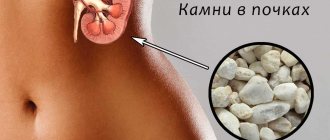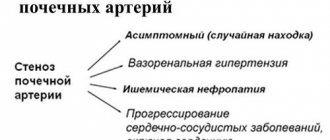Glomerular filtration rate test
It is difficult to directly measure glomerular filtration rate, so scientists have developed a formula to indirectly estimate GFR.
Today, the most widely used equation for calculating GFR is one that was developed in 2000 and modified in 2009. It takes into account your age, gender, ethnicity (race), and your creatinine level. [р, р, р] Creatinine is the end product of the creatine-phosphate reaction in muscles during their energy metabolism, work and when muscle injuries occur. It is eliminated from the blood by the kidneys, so the amount of creatinine in the blood is an important indicator of the efficiency of the kidneys.
Since muscle mass changes little from day to day, creatinine production and utilization rates are fairly constant. When the glomerular filtration rate of the kidneys decreases, the level of creatinine in the blood increases. High creatinine = impaired kidney function. [r, r, r]
SCHEME OF Glomerular FILTRATION OF THE KIDNEY
Many laboratories automatically report your GFR level when you test your blood creatinine. Monitoring GFR values often helps in early detection of kidney dysfunction, which is important for preventing further kidney damage.
Because creatinine is released by muscles, external or internal conditions that affect the muscles will also affect GFR. People with muscle disease, obesity, amputations, or paralysis require alternative ways to determine glomerular filtration rate. Also, more accurate analysis is needed for young people (under 18 years of age) and pregnant women, as they experience changes in muscle mass, which can lead to an underestimation of GFR. [R]
To solve this problem, new formulas have been developed that link GFR to another marker of kidney function, cystatin C. Unlike creatinine, cystatin C can be found in almost all tissues of our body. Many studies have shown that blood cystatin C levels are a more accurate indicator of kidney function than creatinine levels.
Finally, there are special equations for calculating GFR in children that take into account the child's height. [R]
Glomerular filtration of the kidneys and the norm: calculation formula
The structural unit of the kidney is the nephron, which is responsible for the process of filtering blood. The two urinary organs contain about two million nephrons, which are intertwined in groups into small balls. This is the glomerular apparatus (glomerular), in which glomerular filtration of the kidneys occurs.
Important: during the day, from 120 to 200 liters of blood passes through the nephron glomeruli. At the same time, it is in the nephrons that all toxins and breakdown products of proteins, carbohydrates and fats are separated.
The structural unit of the kidney is the nephron, which is responsible for the process of filtering blood
The kidney filtration process is quite simple and straightforward. First, blood enriched with oxygen and other nutrients enters the kidneys, namely the glomerular apparatus. In the nephrons, which have a kind of “sieve,” toxic substances and other breakdown products are separated from water. After this division, water and beneficial microelements (glucose, sodium, potassium) are absorbed back.
Important: it is worth knowing that if a person’s kidneys are sick, then the nephrons in them slowly die one by one. Thus, the filtering function of the urinary organs gradually decreases.
It must be remembered that nephrons, like nerve cells, cannot be restored.
And those nephrons that take on double and triple loads, over time, cease to cope with their function and soon fail.
The rate of filtration in the glomerular apparatus depends on many factors
The rate of filtration in the glomerular apparatus depends on the following factors:
- The rate of plasma transport through the renal glomerular apparatus. That is, it refers to the volume of blood passing through the lumbar arteriole in a certain unit of time. Normally, this figure is 600 ml/min for a person with an average weight of 70 kg.
- An indicator of pressure in the body's vascular system. A normal and healthy body is characterized by higher pressure in the afferent vessel than in the efferent vessel. Otherwise, the filtration process will be difficult and its speed will be reduced.
- Number of healthy nephrons. The more the kidney is affected by the pathological condition, the smaller the filtering area becomes. That is, the number of healthy nephrons decreases.
GFR Estimation
To assess the filtration function of the urinary organs, it is necessary to find out the GFR (rate of the filtration process)
To assess the filtration function of the urinary organs, it is necessary to find out the GFR (rate of the filtration process), which is calculated in ml/min. And the work of the urinary organs itself is assessed by the amount of creatinine in the urine collected from the patient. In order to correctly determine the level of creatinine, a daily volume of urine should be collected from the patient.
As for deducing the glomerular filtration rate (GFR), for this it is necessary to collect urine from the patient using a similar method. Normally, the glomerular apparatus of healthy organs pumps up to 120 ml/min.
It is worth knowing that in patients in the age group 55, the rate of metabolic processes decreases, and therefore the rate of blood filtration in the kidneys also decreases.
The GFR indicator is the rate of formation of primary urine from the filtrate over a certain unit of time.
Important: normally, kidney filtration in healthy organs occurs at a constant rate and remains unchanged until pathological processes develop in the urinary organs.
Pathological processes that change the glomerular filtration rate of the kidneys downwards can be very diverse
Pathological processes that change the glomerular filtration rate of the kidneys downward can be very diverse. In particular, the following pathologies and diseases affect GFR:
- Chronic renal failure. In this case, increased concentrations of creatinine and urea will be noted in the urine. That is, the kidneys cannot cope with their filtration function.
- Pyelonephritis. This inflammatory-infectious disease primarily affects the nephron tubules. And only then does the GFR decline.
- Diabetes. And also with hypertension (high blood pressure), lupus erythematosus, an increased rate of the kidney filtration process is observed.
- Hypotension (low blood pressure). Shock and heart failure can also provoke a decrease in GFR to significant limits.
Measuring GFR makes it possible to identify various diseases and pathological conditions in the early stages
Measuring GFR makes it possible to identify various diseases and pathological conditions in the early stages. At the same time, in order to monitor the filtration process in the kidneys, the method of introducing inulin into the blood is often used - a special control substance that is excreted through the glomerular apparatus. Inulin is administered continuously during the study to maintain a constant concentration in the blood.
Urine collection for analysis while maintaining inulin levels is carried out four times with an interval of half an hour. But it is worth knowing that this method of analyzing the condition of the kidneys is quite complex and is applicable exclusively for scientific purposes.
GFR can also be assessed by the level of creatinine clearance, which directly depends on the patient’s lean body mass. It is worth knowing here that active men have significantly higher creatinine clearance than women and children.
Note that creatinine leaves the body exclusively through the glomerular apparatus. Therefore, if the filtration process in the kidneys is impaired, the concentration of creatinine in the urine increases and is 70% compared to GFR.
Important: when conducting a urine test for creatinine, you need to know that medications can greatly distort the result. Normally, the creatinine level for men is 18-21 mg/kg, and for women 15-18 mg/kg. If the levels are reduced, this may indicate a malfunction of the kidneys.
This method of studying the functioning of the urinary organs is carried out as follows:
- In the morning, the patient is asked to drink half a liter of water on an empty stomach. After this, he must urinate every hour to collect portions of the biomaterial into separate containers.
- When urinating, the patient must note the time of the beginning and end of the act.
- And in the interval between collecting portions of urine, blood is taken from a vein from the patient to determine creatinine clearance. It is calculated using a special formula. The calculation formula looks like this: F1=(u1/p)v1.
Here the following interpretations have meaning:
- Fi is glomerular filtration (its rate);
- U1—content of the control substance in the blood;
- Vi – time of the very first urination after drinking water (in minutes)
- p is the concentration of creatinine in blood plasma.
Creatinine clearance is calculated using the given formula every hour. In this case, calculations are carried out throughout the day.
In order to assess the glomerular filtration rate, a study of endogenous creatinine (creatinine clearance) is used. It is difficult for an ordinary person to understand the meaning of this examination. Let's look at the cases in which such an analysis is prescribed, as well as what pathologies it can identify.
This indicator reflects the condition of the patient’s kidneys, whether there are any diseases and how quickly the organs cleanse the blood of creatinine, excreting it in the urine.
In simple terms, the test can reveal problems with the kidneys and also show how well they cleanse the body.
It is worth remembering that any deviation from the norm may indicate disorders and pathologies, however, a single analysis does not provide a medical conclusion, and the patient is prescribed a comprehensive examination.
The term “clearance” is often used to refer to the glomerular filtration rate. It shows how much blood plasma is released into the urine in 1 minute. It is worth noting that this norm is individual for each patient, however, there are certain numbers, the excess or decrease of which already indicates the presence of some disease in the body.
During the study, creatinine is determined. Glomerular filtration rate can be calculated using a special formula. For testing, a person must provide all urine excreted during the day.
It is collected in a large jar, mixed and poured into a small container before serving directly, and the excess is poured out. It is worth noting that the jar must be stored in a cool place for 24 hours.
Also, to complete the study, a venous blood test is also prescribed, which is used to determine the creatinine level.
Before undergoing the study, the patient must adhere to certain rules:
- 6 hours before the analysis you should not eat meat, poultry, fish, tea and coffee;
- during urine collection there is no need to engage in physical activity, it is better to spend the day at home;
- one day before the test, you must stop taking all medications, but only after communicating with the specialist who prescribed them.
Doctors usually warn that if any abnormalities are identified during the study, the analysis must be repeated.
Total information
It should be noted that urine in the body begins to form in the glomeruli of the kidneys. So what is glomerular filtration rate? The analysis shows how fast blood flows through these same glomeruli.
In a normal person it does not exceed 125 ml/min. That is, the kidneys clear 125 ml of blood from creatinine per minute.
It is not difficult to guess that when the normal indicator falls, stagnation of this substance will form, and venipuncture indicators will be poor.
In the blood serum, the creatinine level will differ from the norm only if its clearance has decreased by more than 50%. The final product is plasma without any admixture of cells or protein. By the way, the creatinine released by the renal glomeruli cannot be absorbed back into the blood, which is why this analysis is considered very accurate and modern.
Calculation of the indicator
Before determining the glomerular filtration rate, it is necessary to understand that two kidneys of a healthy person contain about 2 million nephrons. The levels of creatinine in the urine begin to change when the number of nephrons decreases by a quarter, and a serious disease is diagnosed when this indicator drops by an average of 70-75%.
Calculation methods
The filtration rate is determined in various ways. Some of them are completely new, others have been known for a long time. All calculations are based on an assessment of the concentration in the blood of certain breakdown products - inulin, creatinine, urea - which are not normally retained in the body. The best studies are considered to be studies of the clearance of creatinine, which is formed in the muscles, but is easily excreted by the kidneys in urine. These tests do not exclude small errors. Much depends on age, gender, amount of muscle mass.
Standard formula
This technique for calculating the rate of the filtration process is based on an analysis of the volume of daily urine. Dividing its quantity by time, laboratory workers calculate the indicators. The unit of measurement is ml/min.
If the value does not fit within the norm, then further research is carried out to identify the disease.
An actively used method, one of the first developed (1973, published in 1976). However, determining speed using the formula has disadvantages. It is inaccurate if GFR values are close to normal or slightly reduced. The reason is the variable value of creatinine, it depends on gender, age, and race. Tubular secretion is also not assessed by this method.
CCr = {((140 - age) x weight) / (72xSCr)} x 0.85 (in women), where CCr is creatinine clearance; SCr is serum creatinine measured in mg/dL.
According to Schwartz
This glomerular filtrate rate formula is designed solely for determining GFR in children. Blood serum is also used here.
CCr = kx height / SCr
Height in the formula is measured in centimeters, k (age coefficient) is equal to 0.0484, for children under 3 years old k = 0.0313, for male adolescents - 0.0616. The unit of measurement for serum creatinine is µmol/L.
CKD-EPI
This is the newest formula for analyzing glomerular filtration rate, determined by the amount of creatinine. It was edited in 2011. Being the most effective, this equation gives an accurate estimate if GFR values exceed 60 ml/min/1.73 m2. If the patient is not an average citizen, the method is not used.
The study is excluded after amputation of limbs, in case of exhaustion or obesity, pregnancy, in early and old age, if kidney problems are not observed.
CCr = 141 x min (SCr / k)α x max (SCr / k) -1.209 x 0.993 Age x 1.018 (for women) x 1.159 (for blacks), where k is 0.9 for men, 0.7 for of the weaker sex, α - -0.411 and -0.329, respectively. Serum creatinine is measured in mg/dL.
This method for determining GFR and kidney pathology is very similar to the previous calculation. The same group of scientists worked on it as on CKD-EPI, but this happened a little earlier. Only some coefficients have been changed, so it is also unacceptable for people with small or large muscle mass.
CCr = 175 x SCr-1.154 x age-0.203 x 1.212 (for the Negroid race) x 0.742 (for women)
In this formula, the unit of measurement for serum is also mg/dL.
The main drawback of the technique is the distortion of GFR downward when its real value is high.
There is another option for determining kidney GFR. This is the clearance of endogenous creatinine, called the Rehberg test. This method uses not only blood serum, but also daily urine, collected according to strict rules:
- Food intake is stopped 12 hours before the procedure, alcohol - one day.
- Diuretics are prohibited; the last time the drug is allowed is 48 hours before urine collection.
- The day before the collection of biomaterial is a period that excludes physical activity and strong emotions.
- Smoking is taboo half an hour before GFR tests.
The formula is relatively simple: CCr = (U x V) / P
CR = (CCr - V / CCr) x 100%
The method has an Achilles heel - if urine is collected incorrectly, the results are greatly distorted, so it is rarely used in practice.
Normal glomerular filtration rate (GFR) values
Many different equations can be used to obtain the estimated glomerular filtration rate (GFR). In addition, normal levels of GFR will vary among different ethnic groups. Some laboratories will report two groups—African-American and Caucasian.
All equations for calculating GFR provide a range of values from 0 to about 140. The lower the value, the less efficiently your kidneys work.
The normal filtration rate in young people is considered to be around 90 – 120 ml per minute. [R] However, depending on the laboratory, normal results may be reported as a range of more than 90 or more than 60 ml/min/1.73m2. [R]
OPERATION SCHEME OF THE Glomerulus of the Kidneys by FILTERING BLOOD AND FORMING URINE
GFR decreases with age. In people over 70 years of age, glomerular filtration rates below 60 ml/min/1.73 m2 can be considered normal. [R]
CHANGES IN GFR (glomerular filtration rate) WITH AGE
Important Notes
Glomerular filtration rate is a very accurate and important test, so there are several other important nuances that must be taken into account when undergoing it.
- It is believed that in an adult after 40 years of age, creatinine clearance drops by 6.5 ml/min every 10 years of life. Therefore, a reduced rate for a young body will be considered normal for an elderly person.
- Drugs such as Cimetidine, Trimethoprim and ketonic acids significantly distort the normal result. This should be taken carefully, especially for those patients who have severe renal failure.
- In order for the analysis to be performed correctly, you must follow all recommendations. Determining the glomerular filtration rate is possible only if a person has collected all the urine that was excreted in one day. Missing even one urination may reduce the accuracy of the result.
GFR norm
The kidneys are the body’s natural filter, through which metabolic products, including dangerous toxins, leave the body. In total, they can process up to 200 liters of liquid in 24 hours. After all harmful elements are removed from the water, it returns to the blood again.
Often, to diagnose the effective functioning of the kidneys, the determination of glomerular filtration rate is used, the norm of which is different for each person.
The main problem of the kidney is that under the influence of heavy stress, nephrons die.
As a result, it works worse and worse as a filter, since new elements will no longer be formed. As a result, a lot of different diseases and complications arise. People who drink alcohol, eat a lot of salty foods and have bad heredity are especially prone to this.
If, based on any symptoms, the doctor determines that the patient’s complaints are related to the kidneys, he may be prescribed a diagnostic method such as GFR, that is, determining the glomerular filtrate rate.
Read our article about how the human kidneys work.
In order to determine GFR, special formulas are used. There are several of them, and they differ in information content. But everywhere they use one term, namely clearance. This is an indicator by which you can determine how much blood plasma will be processed in one minute.
Normal values
Experts note that there is no clear standard for GFR, since each organism has individual indicators. However, there are certain boundaries for each age and gender:
- men - 125 ml/min;
- women - 110 ml/min;
- for children under 12 years old - 135 ml/min;
- in newborns - about 40 ml/min.
During normal operation of natural filters, the blood will be completely purified about 60 times a day. With age, the quality of kidney function deteriorates, and the intensity of filtration becomes less.
There are 3 main types of diseases that reduce or increase the filtration rate. Using this indicator, you can get a preliminary diagnosis, and additional tests will give a clearer picture.
The class of diseases that cause a decrease in the GFR rate include:
- Chronic kidney disease (see stages of CKD in the table). This disease leads to increased concentrations of urea and creatinine. In this case, the kidneys cannot cope with the load normally, which leads to the gradual death of nephrons, and then to a decrease in the filtration rate.
- About the same thing happens with pyelonephritis. This disease is infectious in nature. Pyelonephritis is characterized by inflammatory processes that necessarily affect the nephron tubules. This inevitably leads to a decrease in glomerular filtration rate.
- One of the most dangerous conditions can be considered hypotension. In this case, the disease is associated with very low blood pressure. All this can lead to heart failure and a decrease in GFR levels to critical levels.
The class of diseases that provoke increased kidney function includes:
- diabetes;
- high blood pressure (hypertension);
- lupus erythematosus, which also leads to increased stress on the kidneys.
How to calculate?
For this diagnostic method, one of the key roles is played by the speed of the filtration process. It is by this indicator that a dangerous disease can be diagnosed at an early stage. GFR does not give a complete picture, but it will certainly point you in the right direction in the search for an accurate diagnosis.
In order to calculate how much fluid the kidneys can process, volume and time data are used. Therefore, the final result will be displayed in ml/min. In addition, data on the amount of creatinine in urine is used. To do this, a special analysis is carried out, in which it is necessary to collect urine throughout the day.
Daily urine volumes are used to determine GFR. This way, specialists in the laboratory will be able to calculate the approximate volume of liquid per minute, which will be the filtration rate. Next, the indicators are checked against the norm.
GFR levels should be highest in children around 12 years of age. Then the indicators begin to decline. This becomes especially noticeable after the age of 55, when metabolic processes no longer occur so actively in the human body.
Glomerular filtration rate may depend on several factors:
- the volume of blood present in the body;
- pressure in the cardiovascular system;
- the condition of the kidneys themselves and the number of healthy nephrons also plays an important role.
If a person cares about his health, these indicators should be normal.
A healthy person has a relatively stable level of glomerular filtration rate, but it begins to decline after 40 years by one percent annually. There are also gender differences in indicators. The speed limit is not an exact value, as values vary slightly between laboratories.
GFR indicators, called normal:
- In women, the optimal values are considered to be from 70 to 130 ml/min.
- The norm for men is from 90 to 145 ml/min.
- GFR in children is almost independent of age. If in a one-year-old baby this figure is already on par with the indicators of adults - in the range from 80 to 130, then by puberty it remains the same. However, it is advisable to evaluate results according to standards only from the age of two years or older.
In what cases is examination indicated?
As a rule, deviations in clearance indicators from the norm are detected randomly, for example, during routine examinations, but any qualified doctor can, based on external factors, determine whether a person has pathologies that are associated with the kidneys.
So, an analysis of the glomerular filtration rate of the kidneys is prescribed if the patient complains of pain in their area, and there is swelling in the face and ankles.
Also, a similar study is indicated for hypertensive patients and people who experience rare urination. The analysis is necessary when dark urine or blood is found in it, in case of chronic insufficiency, Cushing's syndrome, diabetes mellitus. Creatinine in daily urine
| Floor | Normal indicators |
| men | 5.3-15.9 mmol/day |
| women | 7.1-17.7 mmol/day |
Clearance
| Floor | Normal values |
| men | 75-115 ml/min |
| women | 95-145 ml/min |
Of course, this is not the entire list of pathologies and symptoms when a clearance study is prescribed, but it is worth remembering that absolutely any disease of the kidneys and urinary system requires this analysis. You should not refuse such a procedure, because almost all diseases begin with a mild form and a person practically does not feel any deviations or disruptions in his body.
High glomerular filtration rate
A high glomerular filtration rate is usually not a concern for doctors. However, an increase in GFR may occur at the initial stage of diabetes development or with a decrease in albumin levels in the blood.
High GFR levels are also commonly detected during pregnancy. [R]
When other factors (age, body weight, race) are excluded, a decreased GFR indicates impaired kidney function. It can be an acute kidney disease or a chronic disease that is often irreversible and continually progresses.
Factors distorting indicators
It is not difficult to guess that in order to obtain a reliable examination result, the patient must follow certain rules, which were indicated above. If he was negligent in complying with the laboratory’s requirements, then the indicators may differ significantly from the norm and the patient will be prescribed a new referral. For example, a low glomerular filtration rate can be detected if the biomaterial is poorly stored (warm place) or is not submitted for research on time.
In addition, the result may exceed the norm or be less than it if the patient was actively involved in sports the day before. Also, some medications can significantly distort the result, which will be an indication for re-examination. Among them:
- "Cimetidine";
- "Trimethoprim";
- "Quinidine" and others.
Do not forget that before undergoing such a serious analysis, you need to talk with a specialist about taking any medications.









